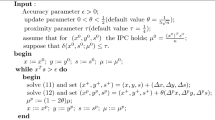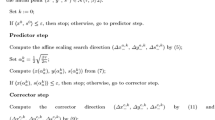Abstract
We present a predictor-corrector algorithm for linear optimization based on a modified Newton direction. In each main iteration, the algorithm operates two kinds of steps: a modified Newton step and a damped predictor step. The modified Newton step is generated from an equivalent reformulation of the centering equation from the system, which defines the central path, and move in the direction of a small neighborhood of the central path. While the damped predictor step is used to move in the direction of optimal solution and reduce the duality gap. The procedure is repeated until an ϵ-approximate solution is found. We derive the complexity for the algorithm, and obtain the best-known result for linear optimization.

Similar content being viewed by others
References
Andersen, E., Andersen, K.: The MOSEK interior point optimizer for linear programming: an implementation of the homogeneous algorithm. High Perform. Optim. 91(3), 197–232 (2000)
Cartis, C.: Some disadvantages of a Mehrotra-type primal-dual corrector interior point algorithm for linear programming. Appl. Numer. Math. 59(5), 1110–1119 (2009)
Karmarkar, N.: A new polynomial-time algorithm for linear programming. In: Proceedings of the Sixteenth Annual ACM Symposium on Theory of Computing, pp. 302–311. ACM, New York (1984)
Lan, G., Monteiro, R., Tsuchiya, T.: A polynomial predictor-corrector trust-region algorithm for linear programming. SIAM J. Optim. 19, 1918–1946 (2009)
Megiddo, N.: Pathways to the optimal set in linear programming. In: Progress in Mathematical Programming: Interior Point and Related Methods, pp. 131–158 (1989)
Mehrotra, S.: On the implementation of a primal-dual interior point method. SIAM J. Optim. 2, 575–601 (1992)
Peng, J., Terlaky, T., Zhao, Y.: A predictor-corrector algorithm for linear optimization based on a specific self-regular proximity function. SIAM J. Optim. 15(4), 1105–1127 (2005)
Roos, C., Terlaky, T., Vial, J.: Theory and Algorithms for Linear Optimization: An Interior Point Approach. Wiley, New York (1997)
Salahi, M., Terlaky, T.: Mehrotra-type predictor-corrector algorithm revisited. Optim. Methods Softw. 23(2), 259–274 (2008)
Salahi, M., Peng, J., Terlaky, T.: On Mehrotra-type predictor-corrector algorithms. SIAM J. Optim. 18(4), 1377–1397 (2007)
Sturm, J.: Using SeDuMi 1. 02, a Matlab toolbox for optimization over symmetric cones. Optim. Methods Softw. 11(1), 625–653 (1999)
Vanderbei, R.: Loqo: an interior point code for quadratic programming. Optim. Methods Softw. 11(1), 451–484 (1999)
Wright, S.: Primal-Dual Interior-Point Methods. Society of Industrial. Society for Industrial and Applied Mathematics, Philadelphia (1997)
Ye, Y.: Interior Point Algorithms: Theory and Analysis. Wiley, New York (1997)
Zhang, Y.: Solving large-scale linear programs by interior-point methods under the Matlab environment. Optim. Methods Softw. 10(1), 1–31 (1998)
Zhang, Y.: User’s guide to LIPSOL: linear programming interior point solver v0. 4. Optim. Methods Softw. 11(1/4), 385–396 (1999)
Zhang, L., Xu, Y.: A full-newton step interior-point algorithm based on modified newton direction. Oper. Res. Lett. 39(5), 318–322 (2011)
Zhu, X., Peng, J., Terlaky, T., Zhang, G.: On implementing self-regular proximity based feasible IPMs. McMaster University Advanced Optimization Laboratory AdvOL-Report 3 (2004)
Author information
Authors and Affiliations
Corresponding author
Additional information
Xu’s research is supported by the Natural Science Foundation of Zhejiang Province No. Q12A010085. Zhang’s research is supported by the grant from National Natural Science Foundation of China No. 11171373.
Rights and permissions
About this article
Cite this article
Xu, Y., Zhang, L. & Jin, Z. A predictor-corrector algorithm for linear optimization based on a modified Newton direction. J. Appl. Math. Comput. 40, 73–86 (2012). https://doi.org/10.1007/s12190-012-0553-0
Received:
Published:
Issue Date:
DOI: https://doi.org/10.1007/s12190-012-0553-0
Keywords
- Linear optimization
- Complexity analysis
- Interior-point algorithm
- Predictor-corrector algorithm
- Modified Newton direction




